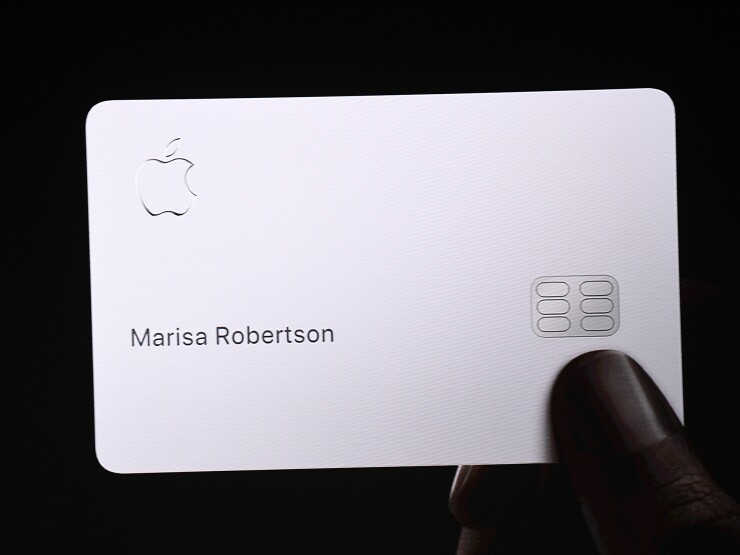
Banks looking to earn Apple's lucrative
JPMorgan Chase is the latest bank with eyes for Apple Card following the dissolution of the technology giant's
Apple's credit card business is one of the most attractive portfolios on the market and would be a beneficial partnership for most major banks, said Elias Ghanem, global head of Capgemini Research Institute for financial services. "The Apple portfolio is healthy, wealthy and premium."
Apple Card users are also more likely to carry an outstanding credit card balance, which in the credit card industry is referred to as "open to buy," said Richard Crone, chief executive and founder of Crone Consulting, an independent advisory firm for the payments industry.
"The Apple Card user is more affluent, better educated [and] younger," Crone said, noting that Crone Consulting independently estimates that the percentage of active users using Apple Card is twice that of the wider credit card industry.
Nearly 40% of Apple Card owners had an annual income of $100,000 or more in 2023, and 34% of Apple Card users had an income between $50,000 and $99,999 according to a July 2023 Statistica survey. Over half were millennials.
But the bank or issuer that ends up partnering with the Cupertino, Calif.-based technology company won't just be buying a premium portfolio, it will be buying growth that is growing at a much faster clip than the rest of the credit card industry.
"When the Apple Card was launched in 2019, it was the most successful launch in history of a credit card — more users in the shortest period of time, ever," Crone said. "From 2019 to 2021, it grew at more than 53% compounded annual growth rate."
Apple's credit card business has a CAGR between 31% and 42%, according to Crone Consulting's estimates. That's compared with a 4% to 6% CAGR for the top 10 credit card issuers that hold 90% of purchasing value.
Apple's credit card business would be a welcomed addition to the portfolio of any of the top 10 issuers, which are American Express, Bank of America, Capital One, Citigroup, Discover, PNC, TD Bank, Synchrony and U.S. Bank, in addition to JPMorgan Chase, Crone said.
That growth comes at a premium, however. Goldman Sachs could have paid Apple as much as $300 per account that is opened through Apple Pay in an arrangement that is commonly referred to in the credit card industry as a bounty, according to Crone Consulting.
At that rate, Goldman could have paid up to $3.6 billion over the life of the partnership servicing the 12 million active Apple Card users.
"Any of the top 10 [credit card issuers] would be attracted to this portfolio," Crone said. "Whether or not they have the position to negotiate down the bounties, that's another story."
Higher-than-average delinquency rates on the Apple Card when compared with other cards issued to a similar borrowing base could also be used as leverage to negotiate down the total price of the partnership, said Aaron McPherson, principal at AFM Consulting. Goldman Sachs through the first nine months of 2022 reported a
"The Apple Card has always occupied a strange place in the market, being partly an affinity card and partly a store card. For a store card, you might tolerate a higher default rate in the interest of getting more sales; however, for an affinity card, you want a market-standard default rate," McPherson said.
"It appears that where Apple is going with the Apple card is toward the affinity card space, with the store card function being taken on by
McPherson estimates that JPMorgan Chase, if it were to secure the partnership, might increase underwriting guidelines to give the Apple Card offering a more premium position.
Crone pegs the higher delinquency rate not on the health of the consumer, but on Goldman's substandard servicing capabilities.
"The interface between Goldman Sachs and Apple Pay was inadequate," Crone said. "This is definitely a greenfield opportunity … but it all boils down to whether [the bank] can service it efficiently and reduce the attended call rate."
Acquiring Apple's credit card business also provides other account-opening opportunities using Apple's multi-factor biometric identification verification.
"This enables Chase — or any issuer that picks up this portfolio — to open new accounts at the edge of the network, leveraging the identity verification capabilities of Apple Pay to reduce risk," Crone said.
"Perfecting that for the Apple Card will allow them to open an auto loan, mortgage, consumer lines of credit, buy now/pay later, [or] a checking account, all through Apple Pay," he said.
Apple's ecosystem has proven to be an effective avenue to cross-sell other financial products. For example, in 2023 less than four months after Apple launched a high-yield savings account for Apple Card customers, it reached more than
"That's why the bounties are the sticking point," Crone said. "They're not just thinking of bounties for opening an Apple Card; they would use that infrastructure for opening all other kinds of accounts."






